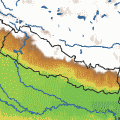GROUP DIVISION AMONG STUDENTS
There were nine groups and four students in each group. Each group works separately. They are named as A, B, C, D, E, G, H, I and J. We belong to group (I).
GROUP MEMBERS
S.N. | NAME | ROLL NO. |
1. | SHIVA RAM DHAKAL | 02-137 |
2. | NABIN RAJ BHANDARI | 02-109 |
3. | SURESH ADHIKARI | 02-134 |
4. | NABI BASNET | 02-108 |
5. | MD. FIROZ | 02-143 |
WORKING SCHEDULE FOR GROUP I
S.N. | DATE | DAILY FIELD WORK |
j | 4th April | Reccee and Pegging Day |
2. | 15th April | Major traversing Day. |
3. | l6th April | Road Alignment, Pegging Survey Day. |
4 | 17th April | Road Alignment and detailing Survey. |
5 | 18th April | River, Bridge Site and detailing Survey. |
6 | 19th April | Major Traversing Day. |
7 | 20th April | Leveling Day. |
8 | 21St April | Minor Traverse and Detailing Day. |
9 | 22nd April | Minor Traverse and Detailing Day. |
10. | 23nd April | Curve setting ,Two peg test, Evaluation Day |
Ø 14th April, Reccee day: - Since it was the first day of our project work. In that day our teachers gave us a brief explanation about the survey work. Then, we made the reccee of the whole camp area three times in order to make the traverse legs with in 1:2 ratio of the minimum to maximum traverse distance. After that we started pegging to cover the whole area for major traverse as far as possible. We also recce for the minor traverse of the given area and pegging were also done. Some of legs, two-way tape measurements of the control points were also noted.
Ø 15th April, Major traversing day: - The chaining of all the traverse legs were measured as Two-way measurement. Then, we started to measure the angles and distances of the traverse with the help of Theodolite. For that we take the two-sets (Face-Left and Face- Right) of reading from each station.
Ø l6th April, 17th April, Road alignment day: - On that day we first aligned the road on given route with the help of abney level and compass and pegging was done for control points simultaneously. Some curve settings were also done on that day. The cross-sections were taken at every 15 meters intervals and at the curve setting also. The chainage of the road aligned was also noted. After finishing the road alignment work, we immediately started bridge site surveying by using different methodologies.
Ø l8th April, Bridge site surveying day:- The triangulation, Profile leveling of river, Lsection (U/S 150m & D/S lOOm @ 25m), X-section, detailing, high flood level, the river bank was noted on that day.
Ø 19th April, Major traversing day: - the remaining work on 15th April, angle and distance measurements were continued on that day.
Ø 2Oth April, Leveling day: - On that day the fly leveling were done to transfer the given R.L. at Krishna Mandir to the T.B.M. inside the campus area near the main gate. To do that first two-peg test was done to check the accuracy of the leveling instrument. After transferring the R.L. to the T.B.M. then, the R.L. was transferred to the control points of the major traverse as well as to the control points of the minor traverse.
Ø 2lst April, 22nd April, Minor traversing and leveling day: - On that day taping of the minor traverse was done as done that for major traverse. In the given area loop was made to cover that area, which did not covered from the major and minor control points. Then the angular and length measurements were done for minor traverse with the help of Theodolite. For that only the single set of reading was taken. And Simultaneously the R.L. was transferred to the all stations. On that day, detailing was done by using theodolite. After setting the theodolite at any major or minor station horizontal zero was set in one of the traverse leg and required vertical angle, horizontal angle & three wire reading were taken.
Ø 23rd April, Evaluation day: - In this day different curves are setted, two peg tests is done, And lastly Evaluation of group and individual are done by teachers with the help of viva.






